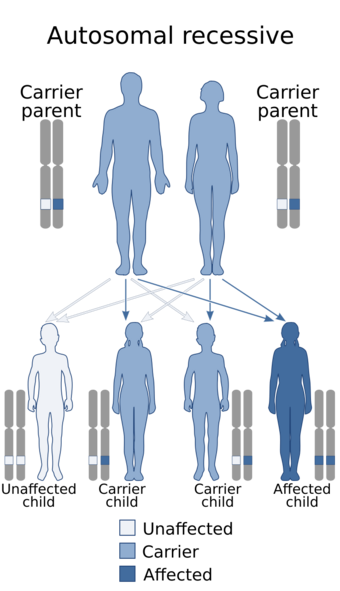Medicine:Carey Fineman Ziter syndrome
| Carey Fineman Ziter syndrome | |
|---|---|
 | |
| Autosomal recessive pattern is the inheritance manner of this condition | |
| Specialty | Medical genetics |
Carey Fineman Ziter syndrome is a rare genetic condition. Fewer than 10 cases have been reported in the literature.[1]
Signs and symptoms
Several features have been described in this syndrome. These include:
- cleft palate
- micrognathia
- laryngostenosis
- developmental delay
- small pons
- scoliosis
- myopathy
- intermittent episodes of hypertension
- Poland sequence
- Möbius sequence
- hydronephrosis
- bilateral clubfeet (talipes)
Genetics
Mutations in the gene Myomaker (MYMK) have been shown to be responsible for this condition.[2] The gene is located on the long arm of chromosome 9 (9q34.2). Inheritance is autosomal recessive.
Pathogenesis
The Myomaker gene encodes a transmembrane protein that is found on the surface of muscle cells. Mutations in this protein result in failure of myoblast fusion.[2][3]
Diagnosis
Diagnosis is made by sequencing the MYMK gene.
Previously diagnosis could be made on clinical features, though brain anomalies could only be determined with an MRI.[4]
Differential diagnosis
Treatment
There is no curative treatment known. Management is supportive.
History
The condition was first described in 1982.[5]
Jordan River Anderson, born in 1999 in and died in 2005, was diagnosed with Carey Fineman Ziter syndrome and lived his entire life in hospital in Winnipeg, Manitoba, Canada . There were plans for him to live outside hospital with family but funding was subject to a jurisdictional dispute between the federal government of Canada and the provincial government of Manitoba because the federal government has financial responsibilities for health and education of Indigenous First Nations people in particular. Jordan became the namesake of Jordan's Principle in Canadian First Nations policy, stipulating that government-funded public services should be to First Nations children promptly and work out later which level of government will ultimately pay for any services whose funding is in dispute. Jordan River Anderson, the Messenger is a 2019 documentary film about Jordan and the campaign for and enactment of the principle.
References
- ↑ Dufke A, Riethmüller J, Enders H (2004). "Severe congenital myopathy with Möbius, Robin, and Poland sequences: new aspects of the Carey-Fineman-Ziter syndrome". Am J Med Genet A 127A(3):291-293
- ↑ 2.0 2.1 Di Gioia SA, Connors S, Matsunami N, Cannavino J, Rose MF, Gilette NM, Artoni P, de Macena Sobreira NL, Chan WM, Webb BD, Robson CD, Cheng L, Van Ryzin C, Ramirez-Martinez A, Mohassel P, Leppert M, Scholand MB, Grunseich C, Ferreira CR, Hartman T, Hayes IM, Morgan T, Markie DM, Fagiolini M, Swift A, Chines PS, Speck-Martins CE, Collins FS, Jabs EW, Bönnemann CG, Olson EN; Moebius Syndrome Research Consortium, Carey JC, Robertson SP, Manoli I, Engle EC. Collaborators: Andrews CV, Barry BJ, Hunter DG, Mackinnon SE, Shaaban S, Erazo M, Frempong T, Hao K, Naidich TP, Rucker JC, Zhang Z, Biesecker BB, Bonnycastle LL, Brewer CC, Brooks BP, Butman JA, Chien WW, Farrell K, FitzGibbon EJ, Gropman AL, Hutchinson EB, Jain MS, King KA, Lehky TJ, Lee J, Liberton DK, Narisu N, Paul SM, Sadeghi N, Snow J, Solomon B, Summers A, Toro C, Thurm A, Zalewski CK (2017). "A defect in myoblast fusion underlies Carey-Fineman-Ziter syndrome". Nat Commun 8:16077. doi: 10.1038/ncomms16077
- ↑ Hedberg-Oldfors C, Lindberg C, Oldfors A (2018). "Carey-Fineman-Ziter syndrome with mutations in the myomaker gene and muscle fiber hypertrophy". Neurol Genet 4(4):e254. doi: 10.1212/NXG.0000000000000254
- ↑ "Carey-Fineman-Ziter syndrome" (in en). 2006. https://www.orpha.net/consor/cgi-bin/OC_Exp.php?Lng=GB&Expert=1358. Retrieved 4 August 2018.
- ↑ Carey JC, Fineman RM, Ziter FA (1982). "The Robin sequence as a consequence of malformation, dysplasia, and neuromuscular syndromes". J Pediatr 101(5):858-864
| Classification |
|---|
 |
